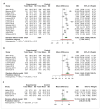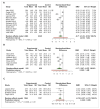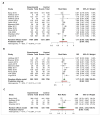Mixed-Method Systematic Review and Meta-Analysis of Shared Decision-Making Tools for Cancer Screening
- PMID: 37568683
- PMCID: PMC10417450
- DOI: 10.3390/cancers15153867
Mixed-Method Systematic Review and Meta-Analysis of Shared Decision-Making Tools for Cancer Screening
Abstract
This review aimed to synthesize evidence on the effectiveness of shared decision-making (SDM) tools for cancer screening and explored the preferences of vulnerable people and clinicians regarding the specific characteristics of the SDM tools. A mixed-method convergent segregated approach was employed, which involved an independent synthesis of quantitative and qualitative data. Articles were systematically selected and screened, resulting in the inclusion and critical appraisal of 55 studies. Results from the meta-analysis revealed that SDM tools were more effective for improving knowledge, reducing decisional conflict, and increasing screening intentions among vulnerable populations compared to non-vulnerable populations. Subgroup analyses showed minimal heterogeneity for decisional conflict outcomes measured over a six-month period. Insights from the qualitative findings revealed the complexities of clinicians' and vulnerable populations' preferences for an SDM tool in cancer screening. Vulnerable populations highly preferred SDM tools with relevant information, culturally tailored content, and appropriate communication strategies. Clinicians, on the other hand, highly preferred tools that can be easily integrated into their medical systems for efficient use and can effectively guide their practice for cancer screening while considering patients' values. Considering the complexities of patients' and clinicians' preferences in SDM tool characteristics, fostering collaboration between patients and clinicians during the creation of an SDM tool for cancer screening is essential. This collaboration may ensure effective communication about the specific tool characteristics that best support the needs and preferences of both parties.
Keywords: cancer screening; decision support techniques; patient-centered care; physician–patient relations; shared decision-making; vulnerable populations.
Conflict of interest statement
The authors declare no competing interests and all authors contributions are duly documented. Changes to the agreements were also addressed.
Figures





References
-
- WHO . World Health Organization; 2022. [(accessed on 8 November 2022)]. Cervical Cancer Screening. Available online: https://www.who.int/data/gho/indicator-metadata-registry/imr-details/3240.
-
- Broeders M., Moss S., Nyström L., Njor S., Jonsson H., Paap E., Massat N., Duffy S., Lynge E., Paci E. The Impact of Mammographic Screening on Breast Cancer Mortality in Europe: A Review of Observational Studies. J. Med. Screen. 2012;19((Suppl. 1)):14–25. doi: 10.1258/jms.2012.012078. - DOI - PubMed
-
- De Koning H.J., Van Der Aalst C.M., De Jong P.A., Scholten E.T., Nackaerts K., Heuvelmans M.A., Lammers J.-W.J., Weenink C., Yousaf-Khan U., Horeweg N., et al. Reduced Lung-Cancer Mortality with Volume CT Screening in a Randomized Trial. N. Engl. J. Med. 2020;382:503–513. doi: 10.1056/NEJMoa1911793. - DOI - PubMed
Publication types
Grants and funding
LinkOut - more resources
Full Text Sources

